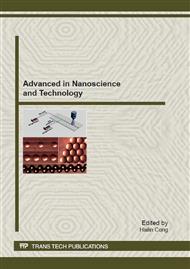[1]
N. M. Rodriguez and A. Chambers, R. T. K. Baker, Catalytic engineering of carbon nanostructures, Langmuir 11, (1995) 38-62.
Google Scholar
[2]
A. Thess, R. Lee, P. Nikolaev, P. Dai, P. Petit, J. Robert, C. Xu, Y. H. Lee, S. G. Kim, A. G. Rinzler, D. T. Colbert, G. E. Scuseria, D. Tomanek, J. E. Fisher, R. E. Smalley, Crystalline ropes of metallic carbon nanotubes, Science 273 (1996).
DOI: 10.1126/science.273.5274.483
Google Scholar
[3]
T. W. Ebbesen, P. M. Ajayan, Large-scale synthesis of carbon nanotubes, Nature 358(1992), 220.
DOI: 10.1038/358220a0
Google Scholar
[4]
W. Xia, D. -S. Su, A. Birkwer, L. Ruppel, Y. -M. Wang, C. Woll,J. Qian, C. -H. Liang, G. Marginean, W. Brandl, M. Muhler, Chemical vapor deposition and synthesis on carbon nanofibers: sintering of ferrocene-derived supported iron nanoparticles and the catalytic growth of secondary carbon nanofibers, Chem. Mater 17(2005).
DOI: 10.1021/cm051623k
Google Scholar
[5]
S. J. Tran, A. R. M. Verschueren, C. Dekker, Room-temperature transistor based on a single carbon nanotube, Nature 393(1998), 49.
DOI: 10.1038/29954
Google Scholar
[6]
W. B. Choi, J. U. Chu, K. S. Jeong, E. J. Bae, J. W. Lee, J. J. Kim,J. O. Lee, Ultrahigh-density nanotransistors by using selectively grown vertical carbon nanotubes, Appl. Phys. Lett. 79(2001), 3696.
DOI: 10.1063/1.1419236
Google Scholar
[7]
J. Kong, E. Yenilmez, T. W. Tombler, W. Kim, L. Lin, C. S. Jayanthi, S. Y. Wu, R. B. Laughlin, H. Dai. Carbon nanotubes as schottky barrier transistors, Phys. Rev. Lett. 87(2001), 106801.
DOI: 10.1103/physrevlett.87.106801
Google Scholar
[8]
J-M. Bobard, H. Kind, T. Stockli, et al, Solid-State Electron, Field emission from carbon nanotubes: the first five years, (2001)45 (6): 893-914.
DOI: 10.1016/s0038-1101(00)00213-6
Google Scholar
[9]
S S Fan, M G Chapline, N R Franklin, et al, Self-oriented regular arrays of carbon nanotubes and their field emission properties, Science 283(1999), 512-514.
DOI: 10.1126/science.283.5401.512
Google Scholar
[10]
M. Terrones, N. Grobert, J. Olivares, et al, Controlled production of aligned nanotube bundles, Nature 388, (1997)52-55.
DOI: 10.1038/40369
Google Scholar
[11]
Z F Ren, Z P Huang, J W Xu, et al, Synthesis of large arrays of well-aligned carbon nanotubes on glass, Science, 282, (1998). 1105-1107.
DOI: 10.1126/science.282.5391.1105
Google Scholar
[12]
G Zhong, T. Iwasaki, H. Kawarada, et al, Synthesis of highly oriented and dense conical carbon nanofibers by a DC bias-enhanced microwave plasma CVD method, Thin Solid Films (2004)464-465, 315-318.
DOI: 10.1016/j.tsf.2004.06.051
Google Scholar
[13]
B.B. Wang, S. Lee, H. Yan, et al, Study on glow discharge effects on catalyst films for growing aligned carbon nanofibers in negative bias-enhanced hot filament chemical vapor deposition system, Thin Solid Films 474, (2005) 103-108.
DOI: 10.1016/j.tsf.2004.08.022
Google Scholar
[14]
Liyan Yu, The Controllable Synthesis and Growth Mechanism of One-Dimension Carbon Nanomaterials, Ph.D. Thesis, Qingdao University of Science and Technology, (2009).
Google Scholar


